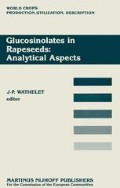Abstract
Plant thioglucoside glucohydrolase (myrosinase EC 3.2.3.1) catalyzes the hydrolysis of glucosinolates to isothiocyanate, glucose and sulfate. We have purified myrosinase from white mustard seed (Sinapis alba) in high yields and with a considerable specific activity in a single step by affinity chromatography on Con-A Sepharose. This myrosinase was suitable for use in our polarographic method, which allows the simultaneous determination of total glucosinolates and free glucose in cruciferous extracts. We compared four methods for measuring myrosinase activity for linearity, sensitivity, reproducibility and suitability for routine work, both for routine analyses of crude myrosinase extracts and for enzyme purification and characterization studies. The methods were: i) pH-Stat Assay (pHSA), which measures the rate of acid released during the hydrolysis of sinigrin substrate; ii) Spectrophotometric Coupled Enzyme Assay (SCEA), employing hexokinase and glucose-6-phosphate dehydrogenase (HK--G6PDH), which measures the rate of glucose released during sinigrin hydrolysis; iii) Direct Spectrophotometric Assay (DSA), in which the substrate hydrolysis rate was measured by following the decrease in absorbance at 227 nm; and, finally, iv) a new Polarographic Coupled Assay (PCA), involving the coupled enzymes glucose oxidase and catalase, which measures the rate of glucose released during substrate hydrolysis as O2 uptake. Although pHSA and PCA showed comparable activities and were linear with increasing amounts of purified enzyme greater than 10 µg, these methods are not suitable for routine work because pHSA requires extensive sample dialysis and PCA shows poor sensitivity. DSA and SCEA gave 18% and 33% lower myrosinase activities, respectively, compared to pHSA; in addition, SCEA was nonlinear with increasing amounts of enzyme above 1 µg. As expected, the lower activity for DSA was due to the suboptimum substrate concentration while for SCEA, this result depends to the low concentrations of Mg++ and HK--G6PDH. In conclusion, DSA appears to be better than the other methods both for enzyme kinetic studies and, if used with care, for routine analyses of crude myrosinase.
Access this chapter
Tax calculation will be finalised at checkout
Purchases are for personal use only
Preview
Unable to display preview. Download preview PDF.
References
Björkman,R. 1976. Properties and function of plant myrosinases,in: The Biology and Chemistry of Cruciferae, p. 191–205 Academic Press, London.
Björkman,R.,Lonnerdal,B. 1973. Studies on myrosinases. III. Enzymatic properties of myrosinases from Sinapis alba and Brassica napus seeds. Biochim. Biophys. Acta, 327, 121–131.
Bradford,M. 1976. A rapid and sensitive method for the quantitation of microgram quantities of protein utilizing the principle of protein-dye binding. Anal. Biochem., 72, 248–254.
Croft,A.G. 1979. The determination of total glucosinolates in rapeseed meal by titration of enzyme-liberated acid and the identification of individual glucosinolates. J.Sci.Food Agric., 30, 417–423.
Gil,V., MacLeod, A.J. 1980. Studies on glucosinolate degradation in Lepidium Sativum seed extracts. Phytochemistry, 19, 2547–2551.
Heaney R.K.,Fenwick G.R. 1981. A micro-column method for the rapid determination of the total glucosinolate content of cruciferous material. Z. Planzenzucht. 87, 89–95.
Iori,R.,Leoni,O.,Palmieri,S. 1983. A polarographic method for the simultaneous determination of total glucosinolates and free glucose of cruciferous material. Anal.Biochem., 134, 195–198.
Helboe,P.,Olsen,O.,Sorensen,H. 1980. Separation of glucosinolates by high performance liquid chromatography. J.Chromatography, 197, 199–205.
Orr,C.W.M. 1967. Studies on Ascorbic acid. I. Factors influencing the ascorbate-mediated inhibition of catalase. Biochemistry, 2995–3000.
Palmieri,S.,Leoni,O.,Iori,R. 1982. A steady-state study of myrosinase with direct ultraviolet spectrophotometric assay. Anal.Biochem., 123, 320–324.
Palmieri,S.,Iori,R.,Leoni,O. 1986. Myrosinase from Sinapis alba L.: A new method of purification for glucosinolate analyses. J.Agric.Food Chem., 34, 138–140
Schwimmer, S. 1961. Spectral changes during the action of myrosinase on sinigrin. Acta Chem. Scand., 15, 535–544.
Thies,W. 1976. Quantitative gas-liquid chromatography of glucosinolates on a microliter scale. Fette Seifen, Anstrichm. 1976, 78, 231–234.
Tookey,H.L.,Van Etten,C.H.,Daxenbichler,M.E. 1980. Glucosinolates. in: Toxic Constituents of Plant Foodstuffs 2ed p.103–142. Academic Press,New York.
Underhill,E.W. and Kirkland, D.F. 1971. Gas chromatography of trimethylsilyl derivatives of glucosinolates, J.Chromatogr., 57, 47
Van Etten, C.H., Daxenbichler,M.E., Peters,J.E., Booth A.N. 1965. J.Agric.Food Chem., 13/1, 24–36.
Wetter, L.R., Youngs, C.G. 1976. A thiourea-UV assay for total glucosinolate content in rapeseed meals. J.Am.Oil Chem.Soc., 53, 162.
Wilkinson,A.P.,Rhodes,M.J.C.,Fenwick,G.R. 1984a. Determination of myrosinase activity by a spectrophotometric coupled enzyme assay. Anal.Biochem., 139, 284–291.
Wilkinson,A.P.,Rhodes,M.J.C.,Fenwick,G.R. 1984b. Myrosinase activity of cruciferous vegetables. J.Sci.Food Agric., 35, 543–552.
Author information
Authors and Affiliations
Editor information
Editors and Affiliations
Rights and permissions
Copyright information
© 1987 ECSC, EEC, EAEC, Brussels-Luxembourg
About this chapter
Cite this chapter
Palmieri, S., Iori, R., Leoni, O. (1987). Comparison of Myrosinase Activity Assays. In: Wathelet, JP. (eds) Glucosinolates in Rapeseeds: Analytical Aspects. World Crops: Production, Utilization, Description, vol 13. Springer, Dordrecht. https://doi.org/10.1007/978-94-009-3615-7_2
Download citation
DOI: https://doi.org/10.1007/978-94-009-3615-7_2
Publisher Name: Springer, Dordrecht
Print ISBN: 978-94-010-8118-4
Online ISBN: 978-94-009-3615-7
eBook Packages: Springer Book Archive

